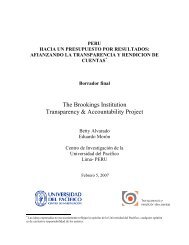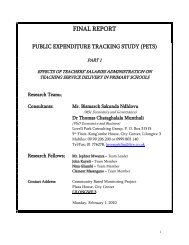Provider Purchasing and Contracting for Health Services_The Case
Provider Purchasing and Contracting for Health Services_The Case
Provider Purchasing and Contracting for Health Services_The Case
Create successful ePaper yourself
Turn your PDF publications into a flip-book with our unique Google optimized e-Paper software.
Table 13 shows the expenditure by the Lusaka District <strong>Health</strong> Management Team, which<br />
does not have district hospital. Despite the high concentration of private <strong>for</strong>-profit health care<br />
providers that provide the first-level referral services in the city, the District <strong>Health</strong><br />
Management Team does not contract with them <strong>for</strong> any clinical services (as evidenced by the<br />
expenditure pattern in table 13). Rather, it refers its clients to the University Teaching<br />
Hospital, which is a third-level hospital.<br />
Table 13: Expenditure by the Lusaka DHMT<br />
Expenditure 2005 Expenditure 2007<br />
District <strong>Health</strong> Office 1,164,336,557 1,312,587,821<br />
First level (University<br />
Teaching Hospital) 613,195,148 800,180,119<br />
<strong>Health</strong> centers 9,366,169,234 6,905,925,635<br />
Public health programs 1,071,197,074 1,293,588,215<br />
Total 12,214,898,013 10,312,281,790<br />
Source: Lusaka DHMT Action Plan.<br />
Constraints to contracting-out<br />
<strong>The</strong>re are a number of reasons that contribute to limited contracting between the private <strong>for</strong>profits,<br />
on the one h<strong>and</strong>, <strong>and</strong> public <strong>and</strong> mission hospitals, on the other. <strong>The</strong> constraints arise<br />
mainly from two sources:<br />
• <strong>The</strong> manner in which contracts are designed, funded, <strong>and</strong> administered<br />
• <strong>The</strong> attitude of managers toward private sector contracting.<br />
<strong>The</strong> design <strong>and</strong> administration of contracts: Most managers at District <strong>Health</strong> Management<br />
Teams observed that although contracting with private <strong>for</strong>-profit health care providers is<br />
allowed, it is in principle difficult to enter into any subcontracts with them because of the<br />
way the contracts between District <strong>Health</strong> Management Teams or Hospital Management<br />
Boards <strong>and</strong> the Ministry of <strong>Health</strong> are designed.<br />
First, the contracts specify where services have to be purchased. <strong>The</strong> design of the referral<br />
system encourages contracting-in as opposed to contracting-out. For instance, the contracts<br />
specify that the District <strong>Health</strong> Management Teams have to purchase health services from<br />
second- <strong>and</strong> third-level providers. At the budgeting stage, these facilities factor in these funds<br />
as part of their budgets <strong>and</strong> merely claim <strong>for</strong> the funds during the implementation of budgets<br />
although commensurate services may not have been delivered.<br />
Second, government funding is not only inadequate but also uncertain in terms of<br />
disbursement. This makes strategic purchasing of health services from the private sector<br />
difficult. Moreover, the private sector may not agree to lower prices to those applicable under<br />
the contracts. 8<br />
Attitudes of managers toward private contracting<br />
Some managers reported that the private sector in their catchment areas does not provide<br />
services that cannot be procured from other government <strong>and</strong> mission facilities. One of the<br />
8 Private <strong>for</strong>-profit providers do not follow the Basic <strong>Health</strong> Care Package costing.<br />
52
















